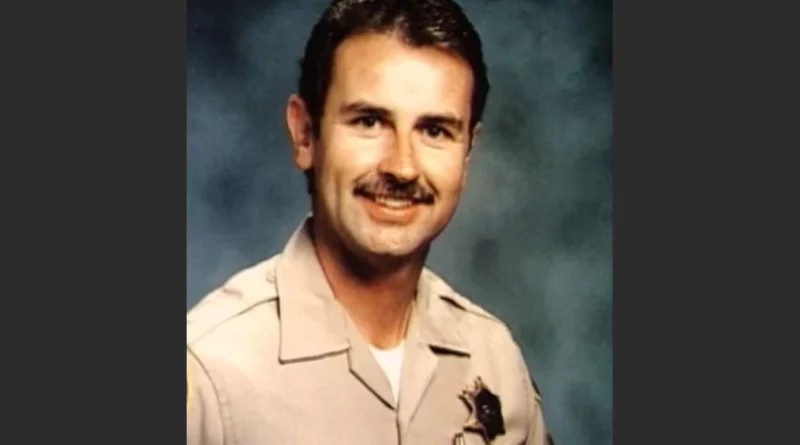Sheriff Deputy Charlie Anderson Killed During Home Invasion in Burbank California
On the evening of January 24, 1987, Los Angeles County Sheriff’s Deputy Charles Robert “Charlie” Anderson arrived at his Burbank home with his family, expecting an ordinary night. Within minutes, that routine return turned catastrophic. Anderson, 35, a husband and father, was shot inside his house on the 1700 block of West Oak Street. The killing stunned a community accustomed to seeing him in uniform, serving and protecting others. The violence unfolded so quickly—and with such peculiar details—that it immediately challenged the simple narrative of a burglary gone wrong and set in motion an investigation that would haunt detectives for years.
Who Charlie Anderson Was
Colleagues remembered Anderson as a steady, dependable deputy—serious about the job, even-tempered with the public, and devoted to his family. Friends described a man who compartmentalized the stress of police work to be present for his wife and young child. He was the sort of neighbor people waved to automatically, the kind of officer whose name was spoken with respect across shifts. That personal reputation collided with the senselessness of the crime, magnifying the shock and raising an early question for investigators: who would dare target a deputy in his own home?
The Last Drive and the First Moments
The Andersons pulled up after an outing, with Charlie taking their older child toward the front door while his wife remained in the car, reportedly resting due to a back injury. It was a small moment that would become a tragic pivot in the narrative: she stayed outside; he went in first. A series of sharp, explosive sounds followed—at first easy to misinterpret as car backfires in a quiet neighborhood, but unmistakable to investigators who later reconstructed the scene. When the family rushed inside, chaos had already claimed the space where they should have felt safest.
The Crime Scene Inside the Home
From the entry to the interior rooms, the evidence presented a complicated picture. There were signs of rummaging, drawers disturbed, objects seemingly displaced—yet several valuable items remained untouched and in conspicuously visible spots. For seasoned detectives, that juxtaposition flagged a possibility they could not ignore: staging. If a thief had truly risked entering an occupied home, why were easily pawned valuables left behind? Why did the pattern of disturbance feel more like a performance than a desperate scramble? These questions seeded doubt about the initial idea of an interrupted break-in and propelled the investigation down more nuanced paths.
The Shot That Changed the Case
Key forensic questions persisted around timing, angles, and proximity. Investigators worked to establish how many shots were fired and from where, how close the shooter stood to Anderson, and whether the weapon’s use suggested familiarity or panic. The trajectory work helped separate accident from intent and lent weight to the theory that the shooter either knew the house’s layout or had scouted it enough to move with confidence. Each minute of reconstruction chipped away at the scenario of a random encounter and raised the possibility of a targeted act.
The “Staged Burglary” Theory
The staging theory became a central spine of the case. The pattern of disturbance did not match typical burglar behavior: valuables left in plain sight, certain items oddly “shuffled” rather than practically stolen, and a general sense that the scene was arranged to say “robbery” without convincingly demonstrating it. Detectives asked themselves: was the ransacking meant to misdirect? If so, what motive lurked behind the stagecraft—personal grievance, fear of exposure, or something tangled in Anderson’s professional life? While the job of a deputy can create enemies, the intimacy of the scene pointed investigators to consider people closer to Anderson’s orbit.
The Anonymous Phone Call
The day after the murder, the case took a haunting turn. A nervous-sounding caller reached out to authorities, claiming to know who killed Anderson. The person was urged to call again and speak at length; the promise never materialized. Whether spooked by the prospect of being recorded or worried about reprisals, the voice on the line disappeared. That brief communication—tantalizing and deeply frustrating—remains one of the case’s most evocative loose ends. It suggested that the truth might be known within some small circle and that fear, rather than ignorance, was keeping it buried.
The Neighborhood, the Timeline, and the Puzzle of Noise
The neighborhood’s character mattered to investigators. In a generally quiet area, unusual sounds carry. Detectives canvassed for anyone who heard the sharp reports or saw shadows moving at odd hours. They examined whether the family’s arrival time was predictable enough for an ambush, or whether the killer acted opportunistically. The narrow window between the family pulling up and the fatal shots underscored how swiftly the perpetrator moved—and how confident that person likely felt about the risk of being seen or heard.
Forensic Threads and Dead Ends
Evidence technicians combed for fingerprints, fibers, shoe impressions, and any latent trace a hurried suspect might leave behind. Early reports indicated a scarcity of foreign prints, an absence that complicated things. If someone had handled items to stage the scene, where was the forensic echo of that activity? The relative cleanliness of the evidence reinforced a suspicion that the perpetrator may have worn gloves or otherwise prepared to avoid leaving a trail. It was a professional’s discipline or a careful layperson’s caution—either way, it made the case far harder to crack.
Personal Versus Professional Motives
Given Anderson’s profession, detectives cast a wide net: cases he worked, individuals he arrested, disputes that could breed vengeance. Yet the choreography inside the house kept tugging the narrative toward familiarity. Random burglars do not usually arrange theatrical disturbances or wait with such precision for a family to return. If the killer knew Anderson’s patterns or felt comfortable inside that home, it tilted the motive field toward personal connections—someone emotionally invested enough to plan or brazen enough to execute the attack in a space associated with family and routine.
The Burden on a Family and a Department
The killing of an officer is uniquely destabilizing to a department. It undermines morale, redraws the boundaries between work and personal safety, and leaves colleagues to grapple with the fear that duty might follow them home. For the Anderson family, the loss was intimate and incalculable. The echo of that night—its sounds, its unanswered questions—reverberated through birthdays, anniversaries, and milestones reached in absence. For the agency, memorials and roll calls became reminders that justice delayed can feel like justice denied, even as the badge community continues to honor a fallen colleague.
Theories & Speculation
The unsolved killing of Deputy Charles Robert “Charlie” Anderson remains one of Burbank’s most perplexing mysteries. Nearly four decades after his death, the absence of an arrest has invited speculation, theories, and whispers that stretch across professional and personal domains. Below are the main lines of thought that have emerged—some grounded in evidence, others in the fog of rumor that often cloaks long-cold cases.
The Botched Burglary Theory
The first and simplest theory presented in 1987 was that Anderson interrupted a burglary in progress. According to early reports, drawers had been pulled open and a few items scattered as though a thief had been startled. Anderson, armed or not, may have surprised an intruder who reacted violently, shooting him before fleeing.
However, several inconsistencies quickly undermined this explanation. Expensive electronics, jewelry, and firearms remained untouched. There were no signs of forced entry through windows or doors. Nothing about the layout of the scene suggested panic or flight—it looked more like a performance designed to resemble a break-in. Detectives began to suspect that the supposed burglary had been staged to conceal a more personal motive.
The Staged Scene Hypothesis
The “staged burglary” became the central investigative theory once forensic teams documented how items appeared carefully rearranged rather than frantically searched. Law enforcement officers know that criminals rarely risk entering a deputy sheriff’s home without specific intent. The pattern of disturbance—neat disarray—implied orchestration rather than chaos.
If the crime was staged, that left two dominant motives: revenge or concealment. Revenge could stem from someone Anderson had crossed professionally; concealment could imply a killer with a personal tie seeking to deflect suspicion. The longer investigators studied the crime scene, the more they leaned toward the latter.
A Targeted Killing by Someone He Knew
Detectives considered whether Anderson had enemies from his police work, but his record was clean and his demeanor uncontroversial. He was not known for brutality or corruption. The idea that a suspect from his past had hunted him down seemed unlikely. That turned attention inward—toward family dynamics, friends, and acquaintances.
Some investigators privately speculated that the killer knew Anderson well enough to access or approach the home without fear. The lack of forced entry supported this. So did the precision and speed of the attack: whoever did it acted with familiarity, not hesitation. This theory implied betrayal from within a circle of trust—someone close enough to plan the murder with intimate knowledge of schedules, behavior, and layout.
The Mysterious Caller
The anonymous phone call received the day after the murder remains one of the most tantalizing details in the entire case. The unidentified man reportedly told investigators he knew who killed Charlie Anderson but refused to identify himself. When detectives informed him the call was being recorded, he panicked and hung up, never to be heard from again.
This call spawned endless speculation. Was it the killer himself, testing the police response? Was it a witness who feared retaliation? Or was it someone seeking attention, inserting themselves into a tragedy they only knew secondhand? The tone of the call—nervous, hesitant—suggested genuine fear, but its meaning remains lost to time. Many investigators still believe that if that caller could be identified, the case could finally move forward.
The Connection to Other Unsolved Cases
In later discussions among enthusiasts and cold case analysts, some noted a curious overlap with another local tragedy: the 1988 killing of Carol Montecalvo, a Burbank woman whose husband was later convicted of her murder. The proximity of the crimes in both geography and timeline led to conjecture that the two cases might share connections through social circles or investigative leads. Officially, no evidence has linked the two, but in true crime circles, such coincidences invite endless comparison.
The Domestic Motive Theory
Perhaps the most controversial theory involves speculation of a domestic dispute or betrayal within the home. Supporters of this idea point to the staging, lack of forced entry, and the unusual detail that Anderson’s wife reportedly waited in the car because of a back injury, entering only after hearing the gunshots. To some, this sequence feels too convenient; to others, it’s simply tragic coincidence.
Detectives never publicly accused any family member of wrongdoing, and no charges were ever filed. However, rumors have persisted—amplified by later internet forums and televised profiles—that investigators privately believed the crime could not have been random. The late-1990s reinvestigation reportedly focused on individuals close to Anderson, though prosecutors ultimately declined to pursue charges citing insufficient evidence.
Revenge from a Past Case
While less supported by evidence, some within law enforcement community speculated that Anderson might have been targeted by someone he had arrested or testified against. Even deputies with generally low-profile assignments can encounter unstable or vindictive individuals. If such a person had tracked Anderson home, they might have waited for an opportunity to strike. Yet this theory suffers from the same flaw as the burglary hypothesis—too little proof and too much precision. A criminal driven by revenge rarely stages a crime scene so meticulously.
The Professional Silencing Hypothesis
A darker, fringe theory that circulates among online amateur sleuths posits that Anderson may have stumbled upon internal wrongdoing—corruption, trafficking, or information worth killing for. Proponents of this idea cite the careful execution of the murder and the subsequent silence as indicators of something deeper than domestic tension. There has never been any verified evidence supporting this claim, but its persistence shows how the vacuum of answers invites conspiracy.
The Late-1990s Investigation and Declined Prosecution
In the late 1990s, renewed investigative effort followed a fresh tip. Detectives reopened interviews, reassessed forensic material, and presented their findings to prosecutors in 1999. Despite months of work, the district attorney’s office declined to file charges, citing insufficient physical evidence to meet the burden of proof. Still, multiple sources indicate that police believed the killer was “close to Charlie.” That phrase—deliberately vague—kept public attention alive but offered no closure.
Theories of Silence and Fear
The final layer of speculation revolves around silence. The killer’s identity, some believe, is known within a small circle but remains unspoken out of loyalty, fear, or guilt. The anonymous caller might have been a member of that circle, and his silence may have been enforced. Others speculate that the killer is deceased, rendering the truth irretrievable. Yet the lack of new evidence has not dulled public curiosity. Each anniversary renews the same haunting questions about what secrets lie buried beneath the quiet streets of Burbank.
Community Memory and the Weight of Time
As years passed, the community’s memory of the event condensed into fragments: a respected deputy, a quiet street, a sudden volley of shots, and a house that seemed to argue with itself—part ransacked, part preserved. Those fragments lodge in the mind because they resist easy synthesis. The case remains emblematic of how a single evening can fork into competing narratives—robbery versus staging, random violence versus intimate betrayal—and how, without a definitive resolution, communities are left to carry unresolved stories forward.
Why This Case Still Matters
Unsolved cases are not only puzzles for detectives; they are pressure points for civic trust. When a crime that strikes at the core of domestic safety—a killing inside a home—goes unresolved, it gnaws at confidence in both security and accountability. The enduring questions around the murder of Charlie Anderson underscore the challenges investigators face when evidence is sparse, staging is suspected, and potential witnesses hesitate. Yet advances in forensic science, changes in relationships, and the simple passage of time can surface new disclosures. Cold does not mean closed; it means waiting for the right combination of courage and facts.
The Open Door for Answers
What ultimately resolves a case like this is rarely a single revelation. It is more often the cumulative effect of a new statement, a clarified timeline, a piece of physical evidence reinterpreted by modern tools, or a renewed willingness by someone on the periphery to speak openly. The anonymous caller who once reached out represents a powerful symbol of what might still be known. Somewhere in the overlap between family life, professional duty, and neighborhood routine, explanations continue to exist. The investigation’s long arc invites anyone with knowledge—however small it may seem—to reconsider what they heard, saw, or were told in confidence.
Remembering Charlie Anderson
At the center of the complexity is a life: a deputy who wore the uniform with pride, a husband and father whose plans ended at his own threshold. Remembering Charlie Anderson means holding two truths at once: the facts as investigators can establish them, and the human meaning that facts alone cannot carry. It means honoring his service while insisting that the question “who did this?” remains alive, not as rumor, but as a mandate for truth. Until the contradictions inside that house are resolved and the staging—if that is what it was—is stripped away, the case remains an unfinished chapter in the story of a man who went home and never walked back out.
Discover more from City Towner
Subscribe to get the latest posts sent to your email.




